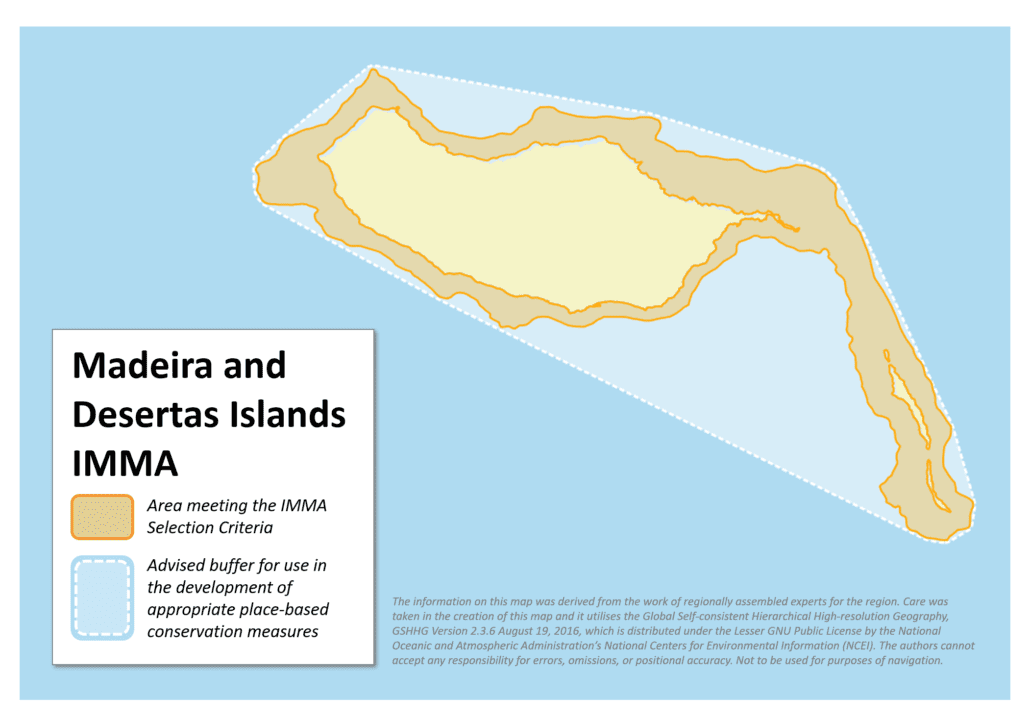Madeira and Desertas Islands IMMA
Size in Square Kilometres
759 km2
Qualifying Species and Criteria
Mediterranean Monk Seal – Monachus monachus
Criterion A; B (1)
Marine Mammal Diversity
Tursiops truncatus
Download fact sheet
Summary
The Madeira archipelago, including the main island or Madeira and the Desertas Islands, inshore waters are the habitat of a small but important population of the Mediterranean Monk Seal (Monachus monachus). The population is reproductively active and has been growing in the last decades, slowly recovering from previous hunt and high mortality rates due to impact of human activities. The area encompasses the year-round habitat used by the monk seal in the archipelago, including rest, reproductive and pupping caves and beaches in the Desertas Islands and resting caves in Madeira. It also encompasses the inshore waters where the animals move, feed, rest and carry out other activities.
Description of Qualifying Criteria
Criterion A – Species or Population Vulnerability
The Mediterranean monk seal is a ‘Threatened Species’, assessed and Red listed as Endangered (EN) (IUCN, 2015b). The IMMA area in the Madeira Archipelago includes all the local crucial habitats for the survival of the species, namely for their rest, reproductive, and pupping caves and beaches in Desertas Islands (Pires et al. 2007) and resting caves in Madeira. These include the inshore waters where the animals move, feed, rest and carry out other activities.
Criterion B: Distribution and Abundance
Sub-criterion B1: Small and Resident Populations
The area fulfils sub-criterion Bi for the monk seal because it is the key area used year-round by this demographically isolated population, estimated at around 40 individuals (Pires, 2011). However recent work allowed to have a more effective estimation of the population that is around 25 individuals (Pires, R., pers. Comm). The closest colony of monk seals is roughly 1000 km south of Madeira, at Cap Blanc, Mauritania. Due to their isolated status within the IMMA all the key reproductive and foraging activities of the monk seal population in Madeira archipelago are located around the Desertas Islands, where the known pupping caves and beaches are and where mating behaviour has been observed and breeding occurs. Neves (1988) and Pires et al. (2007) further recorded and identified feeding sites near the coastline around Desertas Islands. Moreover several anecdotal sightings and recent studies using GPS tracking and TDRs shows that feeding occurs regularly inside of the 200 m depth around the islands of Desertas and also Madeira.
Supporting Information
Hale, R. Pires, P. Santos, & A. A. Karamanlidis, 2011. ‘Mediterranean Monk Seal (Monachus monachus): Fishery Interactions in the Archipelago of Madeira’. Aquatic Mammals, 37(3): 298-305.
Neves, H. C. 1998. ‘Preliminary findings on the feeding behaviour and general ecology strategy of the Mediterranean monk seal Monachus monachus – (Pinnipedia: Monachinae) on the Desertas Islands’. Boletim Museu Municipal do Funchal, 5: 263-271.
Pires, R., Costa Neves, H. & A. Karamanlidis, 2008. ‘The Critically Endangered Mediterranean monk seal Monachus monachus in the archipelago of Madeira: priorities for conservation’, Oryx, 42(2): 278– 285.
Pires, R., Costa Neves, H. & A. Karamanlidis, 2007. ‘Activity Patterns of the Mediterranean Monk Seal (Monachus monachus) in the Archipelago of Madeira’. Aquatic Mammals, 33(3): 327-336.
Pires, R. 2011. Monk Seals of the archipelago of Madeira. Funchal. Serviço do Parque Natural da Madeira, 63p.
https://ifcn.madeira.gov.pt/biodiversidade/projetos/life-madeira-lobo-marinho.html
http://www.lifemadeiramonkseal.com/pt


